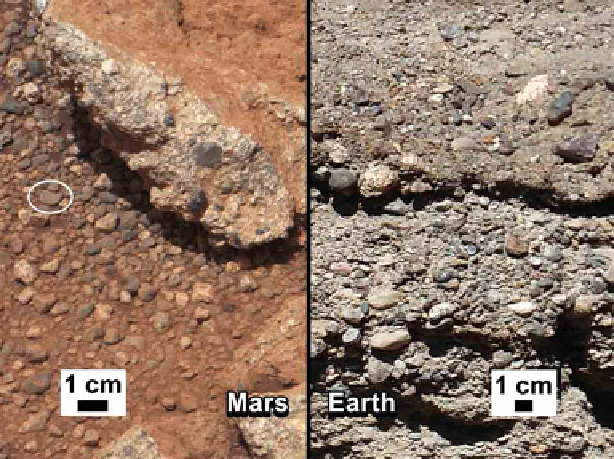Geoscience Reference
In-Depth Information
Fig. 8.19
Rock outcrop on Mars, compared with a terrestrial (right) fluvial conglomerate,
suggesting water “vigorously” flowing in a stream. The outcrop characteristics are consistent with
a sedimentary conglomerate or a rock that was formed by the deposition of water and is composed
of many smaller rounded rocks cemented together - Curiosity rover
(
http://mars.jpl.nasa.gov/msl/
multimedia/images/?ImageID=4720
- NASA/JPL-Caltech/MSSS/PSI, September 2, 2012)
On September 26, 2013, NASA scientists reported that the Mars Curiosity rover
detected abundant chemically bound water (1.5-3 wt%) in soil samples at the
Rocknest region of Aeolis Palus in Gale Crater. In addition, NASA reported that the
rover found two principal soil types: a fine-grained mafic type and a locally derived,
coarse-grained felsic type (Meslin et al.
2013
). The mafic type, similar to other
Martian soils and Martian dust, was associated with hydration of the amorphous
phases of the soil. Also, perchlorates, the presence of which may make detection
of life-related organic molecules difficult, were found at the Curiosity rover landing
site (and earlier at the more polar site of the Phoenix lander) suggesting a global
distribution of these salts (Leshin and MSL Science Team
2013
). NASA also
reported that Jake M rock, a rock encountered by Curiosity on the way to Glenelg,
was a mugearite and very similar to terrestrial mugearite rocks (Various
2014
).
On December 9, 2013, NASA reported that the planet Mars had a large
freshwater lake (which could have been a hospitable environment for microbial life)
based on evidence from the Curiosity rover studying the plain Aeolis Palus near
Mount Sharp in Gale Crater.

Search WWH ::

Custom Search